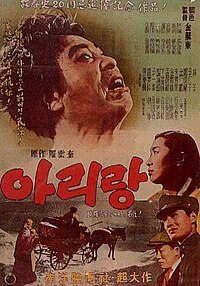| Arirang | |
|---|---|
 1957 film poster 1957 film poster | |
| Hangul | 아리랑 |
| Revised Romanization | Arirang |
| McCune–Reischauer | Arirang |
| Directed by | Na Woon-gyu |
| Written by | Na Woon-gyu |
| Produced by | Yodo Torajo |
| Starring | Na Woon-gyu Shin Il-seon Nam Gung-un Ju In-gyu |
| Distributed by | Choson Cinema Productions |
| Release date |
|
| Running time | (1,599 feet) (9 reels) (roughly 135 minutes) |
| Country | Korea, Empire of Japan |
| Languages | Silent film Korean intertitles |
| Budget | 15,000 Won |
Arirang (Korean: 아리랑) is a 1926 Korean silent film directed by Na Woon-gyu, who is also one of the main cast. It is regarded as one of the most influential films in Korean cinema history, as well as the first Korean nationalist film and a critique of the Japanese rule of Korea. It is named after the traditional song "Arirang," which audiences were said to sing at the conclusion of the film. Arirang is considered a lost film, but a written record of the plot still exists.
Plot
Yeong-jin is a student who has become mentally ill after being imprisoned and tortured by the Japanese for his involvement in the 1 March 1919 protest against the Japanese occupation of Korea. After his release, he returns home to live with his father and sister, Yeong-hui, in their village home. His old friend Hyeon-gu is now in love with Yeong-hui. While the villagers are preoccupied with a harvest festival, O Gi-ho, a collaborator with the Japanese police, attempts to rape Yeong-hui. Hyeon-gu fights Gi-ho, while Yeong-jin watches and has a vision of a couple in a desert begging a man for water. When the man in his imagination embraces the woman rather than offering her water, Yeong-jin stabs him with a sickle, actually killing Gi-ho. Yeong-jin regains his senses at this moment. The film ends with the Japanese police taking Yeong-jin back to prison, while the villagers weep.
Cast
- Na Woon-gyu (羅雲奎) as Yeong-jin (金永鎭)
- Shin Il-seon (申一仙) as Yeong-hui
- Nam Gung-un (南宮雲) as Hyeon-gu
- Ju In-gyu as O Gi-ho
Impact
Initial reception
Arirang premiered at the Dansungsa cinema in Seoul on 1 October 1926, and quickly became a national sensation and a commercial success, screening at cinemas throughout the country. The film was a departure from the standard melodramas popular at the time because of its metaphorical resistance to Japanese colonial rule. It is considered to be Korea's first nationalist film.
Legacy
Arirang is considered to be the first masterpiece of Korean cinema and an inspiration to many Korean filmmakers of the era. Today, the location where Arirang was filmed in Donam-dong, Seoul, is known as Arirang Movie Street. The street is home to Na Woon-gyu Park, the Arirang Cine Center movie theater, and the Arirang Information Library.
Gyeongi Arirang, a variety of the song Arirang is thought to be originated from the song Na Woon-gyu made for the film.

Sequels and remakes
Na Woon-gyu made two sequels to Arirang: a silent film called A Story of the Day after Arirang (1930) and a sound film called Arirang 3 (1936).
Several directors have remade Arirang, including Lee Gang-chon in 1954, Kim So-dong in 1957, Yu Hyun-mok in 1968, and Lee Doo-yong in 2003. Lee Doo-yong's version was the first South Korean film to be publicly screened in North Korea.
Lost status
Along with almost all Korean films of this era, Na Woon-gyu's Arirang is considered to be a lost film. The original nine reels of the film are believed to have been lost during the Korean War. However, a copy of the film was rumored to be in the possession of Japanese collector, Yoshishige Abe, who died in February 2005. His collection of approximately 50,000 films reverted to the Japanese government after his death, but no news has yet come forth as to whether Arirang was found in the collection.
See also
References
- Yecies, Brian; Shim, Ae-Gyung (2011). Korea's Occupied Cinemas, 1893-1948. Routledge. pp. 87–88. ISBN 978-0415995382.
- ^ Bowyer, Justin (2004). The Cinema of Japan and Korea. Wallflower Press. pp. 34–35. ISBN 1904764118.
- Ryfle, Steve; Song-ho, Kim (2016). Yongary, Monster from the Deep Audio Commentary (Blu-ray/DVD). Kino Lorber. Archived from the original on 21 December 2021.
- ^ Min, Eungjun; Joo, Jinsook; Kwak, Han Ju (2003). Korean Film: History, Resistance, and Democratic Imagination. Greenwood Publishing Group. p. 30. ISBN 0275958116.
- Lee, Se-gi (2011). "아리랑 [Arirang]". 죽기 전에 꼭 봐야 할 한국영화 1001 [1001 Korean Movies You Must See Before You Die] (in Korean). Maroni Books. ISBN 9788960531840.
- "Eulogies for legendary director Na Woon-gyu discovered". Yonhap News Agency. 28 September 2016. Retrieved 6 March 2018.
- Kim, Mee-hyun, ed. (2006). "The Japanese Colonial Period, Heyday of Silent Films 1926~1934" (PDF). Korean Cinema: from Origins to Renaissance. Korean Film Council.
- "Arirang Hill - birthplace of Korean film". The Korea Herald. 30 March 2010. Retrieved 6 March 2018.
- 아리랑. Archived from the original on 19 December 2021.
- Yu, Min-yeong (1995). 나운규(羅雲奎) [Na Woon-gyu]. Encyclopedia of Korean Culture (in Korean). Retrieved 6 March 2018.
- Lentz, Robert J. (2008). Korean War Filmography: 91 English Language Features through 2000. McFarland. p. 459. ISBN 978-1476621548.
- 아리랑 1957년 [Arirang (1957)]. Korean Movie Database. Retrieved 6 March 2018.
- 아리랑 1968년 [Arirang (1968)]. Korean Movie Database. Retrieved 6 March 2018.
- "S. Korean Film to Screen in N. Korea". Plainview Daily Herald. Associated Press. 14 May 2003. Retrieved 6 March 2018.
- "Collector's Death May Free Long-Lost Korean Classic Film". Archived from the original on 4 February 2006. Retrieved 27 June 2008.
External links
- Arirang on the Korean Movie Database (in Korean)
- Arirang at IMDb